Question Paper and Solutions of CBSE Xth Science Exam held on 04/03/2020.
Question Paper Code: SET 2 31/1/2
[button type=”default” color=”green” target=”_blank” link=”https://www.educationobserver.com/cbse-10th-social-science-exam-2020-question-paper-and-solutions/”]CBSE Social Science Question Paper and Solutions [/button]
[button type=”default” color=”green” target=”_blank” link=”https://www.educationobserver.com/forum/showthread.php?tid=24452″]CBSE Maths STD Question Paper and Solutions SET 1 [/button]
[button type=”default” color=”green” target=”_blank” link=”https://www.educationobserver.com/forum/showthread.php?tid=24452″]CBSE Maths BASIC Question Paper and Solutions SET 1 [/button]
[button type=”3d” color=”green” target=”_blank” link=”https://www.educationobserver.com/cbse-10th-science-exam-2020-question-paper-solutions/”]New !! CBSE 10th Science Solved Paper 2020- SET 1[/button]
1. Name the functional group present in propanone. [1]
Ans. Ketone is the functional group present in propanone
2. The change in magnetic field lines in a coil is the cause of induced electric current in it. Name the underlying phenomenon. [1]
Ans. Electromagnetic induction is the underlying phenomenon.
Answer question numbers 3(a) to 3(d) and 4(a) to 4(d) on the basis of your understanding of the following paragraphs and the related studied concepts.
3. The growing size of the human population is a cause of concern for all people. The rate of birth and death in a given population will determine its size. Reproduction is the process by which organisms increase their population. The process of sexual maturation for reproduction is gradual and takes place while general body growth is still going on. Some degree of sexual maturation does not necessarily mean that the mind or body is ready for sexual acts or for having and bringing up children. Various contraceptive devices are being used by human beings to control the size of population.
(a) List two common signs of sexual maturation in boys and girls. [1]
(b) What is the result of reckless female foeticide? [1]
(c) Which contraceptive method changes the hormonal balance of the body? [1]
(d) Write two factors that determine the size of a population. [1]
Ans. (a) Common signs of sexual maturation in boys and girls are:
(i) Thick hair growth in the pubic region and armpits.
(ii) The skin becomes oily frequently and there could be occurrence of acne.
(b) Because of uncontrolled female foeticide, child sex ratio is decreasing at an alarming rate in various sections of our society.
(c) The hormonal methods like oral pills create a change in the hormonal balance of the body.
(d) The size of a population is determined by Birth and death rate in a given population.
4. Human body is made up of five important components, of which water is the main component. Food as well as potable water are essential for every human being. The food is obtained from plants through agriculture. Pesticides are being used extensively for a high yield in the fields. These pesticides are absorbed by the plants from the soil along with water and minerals and from the water bodies these pesticides are taken up by the aquatic animals and plants. As these chemicals are not biodegradable, they get accumulated progressively at each trophic level. The maximum concentration of these chemicals gets accumulated in our bodies and greatly affects the health of our mind and body.
(a) Why is the maximum concentration of pesticides found in human beings? [1]
(b) Give one method which could be applied to reduce our intake of pesticides through food to some extent. [1]
(c) Various steps in a food chain represent: [1]
(a) Food web
(b) Trophic level
(c) Ecosystem
(d) Biomagnification
(d) With regard to various food chain operating in an ecosystem, man is a: [1]
(a) Consumer
(b) Producer
(c) Producer and consumer
(d) Producer and decomposer
Ans. (a) The maximum concentration of these chemicals/pesticides get accumulated in the human body when human beings occupy the top level in any food-chain
(b) One method is to consume the food produced through organic farming.
(c) Answer (b)
(d) Answer (a)
5. The compound obtained on reaction of iron with steam is/are: [1]
(a) Fe2O3
(b) Fe3O4|
(c) FeO
(d) Fe2O3 and Fe3O4
Answer (b)
OR
An element ‘X’ reacts with O2 to give ka compound with a high melting point. This compound is also soluble in water. The element ‘X’ is likely to be: [1]
(a) iron
(b) calcium
(c) carbon
(d) silicon
Answer (b)
6. The laws of reflection hold true in the following cases: [1]
(a) plane mirrors only
(b) concave mirrors only
(c) convex mirrors only
(d) all reflecting surfaces
Answer (d)
OR
When an object is kept within the focus of a concave mirror, an enlarged image is formed behind the mirror. This image is: [1]
(a) real
(b) inverted
(c) virtual and inverted
(d) virtual and erect
Answer (d)
7. At the time of short circuit, the electric current in the circuit: [1]
(a) vary continuously
(b) does not change
(c) reduces substantially
(d) increases heavily
Answer (d)
OR
Two bulbs of 100 W and 40 W are connected in series. The current through the 100 W bulb is 1 A. The current through the 40 W bulb will be: [1]
(a) 0.4 A
(b) 0.6 A
(c) 0.8 A
(d) 1 A
Answer (d)
8. The chemical formula for plaster of Paris is: [1]
(a) CaSO4 · 2H2O
(b) CaSO4 · H2O
(c) CaSO4.½ H2O
(d) 2CaSO4 · H2O
Answer (c)
9.In a double displacement reaction such as the reaction between sodium sulphate solution and barium chloride solution: [1]
(A) exchange of atoms takes place
(B) exchange of ions takes place
(C) a precipitate is produced
(D) an insoluble salt is produced
The correct option is:
(a) (B) and (D)
(b) (A) and (C)
(c) Only (B)
(d) (B), (C) and (D)
Answer (d)
10. Baking soda is a mixture of: [1]
(a) Sodium carbonate and acetic acid
(b) Sodium carbonate and tartaric acid
(c) Sodium hydrogen carbonate and tartaric acid
(d) Sodium hydrogen carbonate and acetic acid
Answer: In this question, it should have been asked baking powder instead of baking soda as sodium hydrogen carbonate itself is known as baking soda, then the answer will be option (c)
11. In an ecosystem, 10% of energy available for transfer from one trophic level to the next is in the form of:
(a) heat energy
(b) chemical energy
(c) mechanical energy
(d) light energy
Answer (b)
12. Soil fertility is determined by its ability to: [1]
(a) Decay organic matter
(b) Hold organic matter
(c) Hold water
(d) Support life
Answer (d)
For question numbers 13 and 14, two statements are given – one labelled Assertion (A) and the other labelled Reason (R). Select the correct answer to these questions from the codes (a), (b), (c) and (d) as given below.
(a) Both A and R are true and R is the correct explanation of the Assertion.
(b) Both A and R are true but R is not the correct explanation of the Assertion.
(c) A is true but R is false.
(d) A is false but R is true.
13. Assertion (A): In a homologous series of alcohols, the formula for the second member is C2H5OH and the third member is C3H7OH.
Reason (R): The difference between the molecular masses of the two consecutive members of a homologous series is 144. [1]
Answer (c)
14. Assertion (A): In the process of nuclear fission, the amount of nuclear energy generated by the fission of an atom of uranium is so tremendous that it produces 10 million times the energy produced by the combustion of an atom of carbon from coal.
Reason (R): The nucleus of a heavy atom such as uranium, when bombarded with low energy neutrons, splits apart into lighter nuclei. The mass difference between the original nucleus and the product nuclei gets converted to tremendous energy [1]
Answer (b).
SECTION B
15. What is ‘rusting’? Describe with a labelled diagram an activity to investigate the conditions under which iron rusts. [3]
Ans. Rusting is the phenomenon where slow eating up of iron articles by the action of air, moisture or a chemical on its surface results into the formation of brown flaky substance on it called rust.
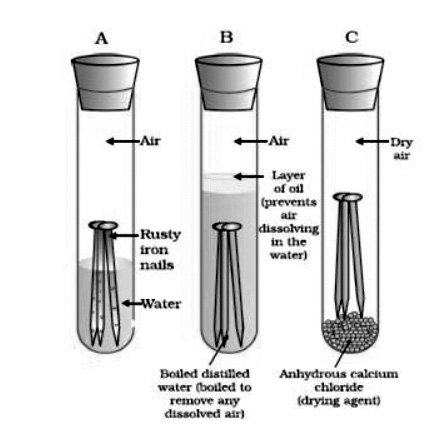
Iron nails rust in test tube A because the nails are exposed to both air and water.,
They do not rust in test tubes B and C. In the test tube B, the nails are exposed to only water, and the nails in test tube C are exposed to dry air.
16. What are homologous structures? Give an example. Is it necessary that homologous structures always have a common ancestor? Justify your answer. [3]
Answer. Homologous structures have organs which are similar in origin and internal morphology but they are different in function and external structure.
Example: Forelimbs of Lizard.
Yes, it is necessary that homologous structures always have a common ancestor. These structures are inherited from a common ancestor and the basic structure of the limbs of reptiles, birds and amphibians are similar though it has been modified during the course of evolution to perform different functions in various vertebrates, depending upon their habitats
17. Why is Tyndall effect shown by colloidal particles? State [3]
Ans. The phenomenon of scattering of light by the colloidal particles is Tyndall effect gives rise to Tyndall effect .
The four instances of observing the Tyndall effect are:
- Tyndall effect can be observed when a fine beam of light enters a smoke filled room through a small hole.
- Tyndall effect can be witnessed when sunlight passes through a canopy of a dense forest.
- Blue colour of eye is due to scattering of light by translucent layer over the iris.
- When a beam of light is directed at a glass of milk, the light is scattered as milk is a colloidal solution of globules of fat and protein.
OR
Differentiate between a glass slab and a glass prism.
What happens when a narrow beam of a monochromatic light, and white light passes through
(a) glass slab and
(b) glass prism? [3]
Answer
- A rectangular glass slab is a refracting medium with three parallel refracting surfaces
- A glass prism is a refracting medium with two or more non-parallel refracting surfaces.
- When a monochromatic light passes through a glass slab, then it displaces parallel to itself and when it passes through a glass prism it gets deviate.
- When a white light passes through a glass slab, then it displaces parallel to itself only and when white light passes through a glass prism get dispersed and deviated.18. Draw a labelled diagram to show
(i) reddish appearance of the sun at the sunrise or the sunset and
(ii) white appearance of the sun at noon when it is overhead [3]
Answer
(i) Reddish appearance of the sun at the sunrise or the sunset

(ii) White appearance of the sun at noon when it is overhead

19. (a) List in tabular form two differences between binary fission and multiple fission. [3]
(b) What happens when a mature Spirogyra filament attains considerable length?
Answer
| Binary Fission | Multiple Fission |
| It occurs during favourable conditions | It can occur under favourable as well as unfavourable conditions. |
| Cytoplasm divides after nuclear division. | Cytoplasm does not divide after every nuclear division. |
(b) Its body breaks up into two or more parts called fragments when a mature Spirogyra filament attains considerable length. each of the parts grows into a new individual.
20. List the important products of the Chlor-alkali process. Write one important use of each. [3]
Ans.
| Products of the Chlor-alkali process | Uses |
|
Sodium hydroxide (NaOH) |
It can be used to make soaps and detergents |
| Chlorine (Cl2) | It can be used for water treatment |
| Hydrogen (H2) | It can be used as a fuel |
OR
How is washing soda prepared from sodium carbonate? Give its chemical equation. State the type of this salt. Name the type of hardness of water which can be removed by it. [3]
Ans. Washing soda can be prepared by recrystallization of sodium carbonate.
Its chemical equation is : Na2CO3 +10H2O –> Na2CO3.10H2O
It is a basic salt.
Permanent hardness of water can be removed using washing soda
21. 3 mL of ethanol is taken in a test tube and warmed gently in a water bath. A 5% solution of alkaline potassium permanganate is added first drop by drop to this solution, then in excess. [3]
(i) How is 5% solution of KMnO4 prepared?
(ii) State the role of alkaline potassium permanganate in this reaction. What happens on adding it in
excess?
(iii) Write chemical equation of this reaction.
Ans. (i) 5% solution of KMnO4 is prepared by dissolving 5 g of KMnO4 crystals in 95 g of water.
(ii) Alkaline KMnO4 acts as an oxidising agent. The colour of KMnO4 will not disappear when added in excess.
(iii) CH3CH2OH —- KmNO4——Heat——-> CH3COOH
22. A squirrel is in a scary situation. Its body has to prepare for either fighting or running away. State the immediate changes that take place in its body so that the squirrel is able to either fight or run [3]
Ans. The following immediate changes take place in the squirrel body which makes it able to either fight or run are:
- Breathing rate increases because of contractions of the diaphragm and the rib muscles.
- Heart beats faster resulting in supply of more oxygen to the muscles.
- Adrenaline is secreted directly into the blood and carried to different parts of the body.
- The blood to the digestive system and skin is reduced due to contraction of muscles around small arteries in these organs.
OR
Why is chemical communication better than electrical impulses as a means of communication between cells in a multi-cellular organism? [3]
Ans. Chemical communication is better than electrical impulses as a means of communication between cells in a multi-cellular organism because:
- Chemical communication is a steady and a persistent response.
- The electrical impulses reach only those cells that are connected by nervous tissue and do not reach each and every cell.
The cell takes some time to reset its mechanisms for the generation and transmission of a new impulse after the generation and transmission of an electrical impulse.
23. (a) State the relation correlating the electric current flowing in a conductor and the voltage applied across it. Also draw a graph to show this relationship.
(b) Find the resistance of a conductor if the electric current flowing through it is 0.35 A when the potential difference across it is 1.4 V. [3]
Ans. (a) If the physical conditions remain unchanged (such as temperature), the potential difference across the two ends of a conductor is directly proportional to the electric current flowing through it.
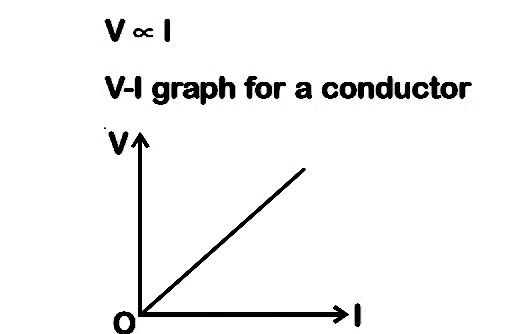
(b) ∴ V=IR
R= 1.4÷0.35= 4 Ω
24 a) Write the mathematical expression for Joule’s law of heating.
b) Compute the heat generated while transferring 96000 coulomb of charge in two hours through a potential difference of 40 V. [3]
Ans (a) H=I2RT
Ans (b) ∴ H = VIT = VQ [ ∴ Q = IT]
H = 40 × 96000
H = 3840000 J
25. (a) What is thermit process? Where is this process used? Write balanced chemical equation for the reaction involved.
(b) Where does the metal aluminium, used in the process, occurs in the reactivity series of metals?
(c) Name the substances that are getting oxidised and reduced in the process. [5]
Ans. (a) Reduction of metal oxides with aluminum powder in which a huge amount of heat is liberated is called thermite process. The reaction of iron (III) oxide with aluminium is a thermit reaction which is used to join railway tracks or cracked machine parts.
Fe2O3(s) + 2Al(s) 2Fe(l) + Al2O3(s) + Heat
(b) Aluminium metal belongs to category of metals of high reactivity in the reactivity series. It is more reactive than zinc and less reactive than magnesium.
(c) Fe2O3 is getting reduced and Al is getting oxidised in this process.
26. (a) What is an electromagnet? List any two uses.
(b) Draw a labelled diagram to show how an electromagnet is made.
(c) State the purpose of soft iron core used in making an electromagnet.
(d) List two ways of increasing the strength of an electromagnet if the material of the electromagnet is fixed. [5]
Ans. (a) An electromagnet is a magnet that runs on electricity. It is a temporary magnet made from a piece of soft iron when current flows in the coil wound around it.
(b) 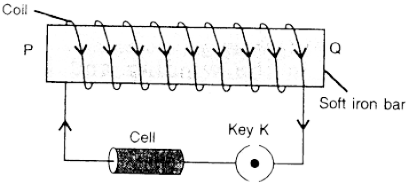
Two uses of electromagnet are:
(i) For removing pieces of iron from wounds
(ii) For lifting and transporting the large masses of iron scrap, grinders, plates etc.
(c) The magnetic field strength inside the solenoid is greatly increased if a core of soft iron is used in making an electromagnet.
(d) Two ways of increasing the strength of an electromagnet if the material of the electromagnet is fixed are:
By increasing the current
By increasing the number of turns of winding
27. Draw a ray diagram in each of the following cases to show the formation of image, when the object is placed: [5]
(i) Between optical centre and principal focus of a convex lens.
(ii) Anywhere in front of a concave lens.
(iii) At 2F of a convex lens.
Ans (i)
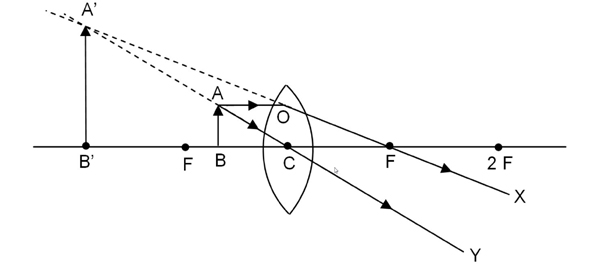
m > 1
Sign of magnification – positive
Ans (ii)
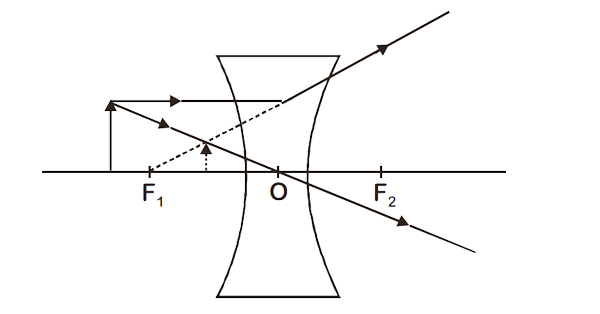
0≤ m < 1
Ans (iii)
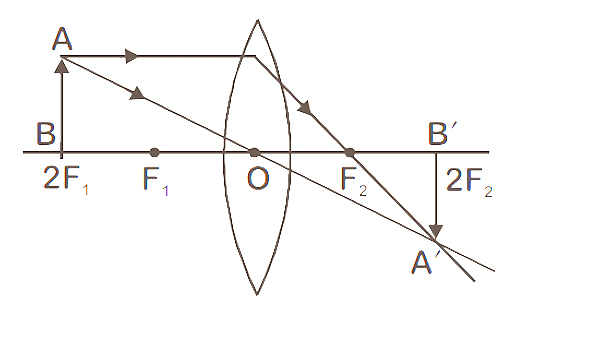
OR
An object 4.0 cm in size, is placed 25.0 cm in front of a concave mirror of focal length 15.0 cm. [5]
(i) At what distance from the mirror should a screen be placed in order to obtain a sharp image?
(ii) Find the size of the image.
(iii) Draw a ray diagram to show the formation of image in this case.
Ans (i) and (ii)
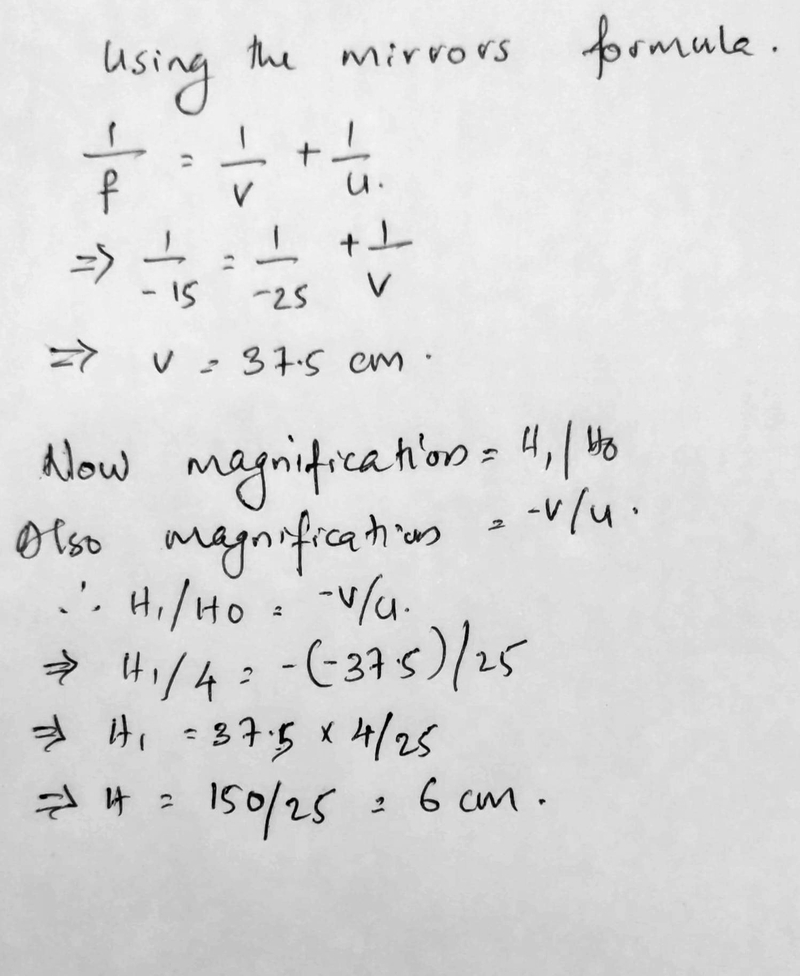
Ans (iii)
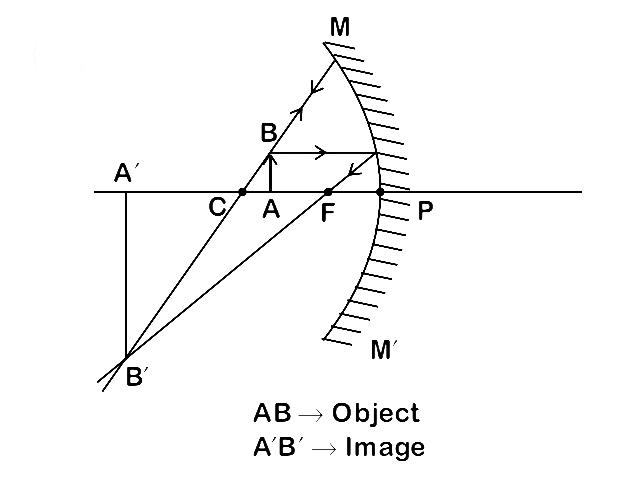
28 (a) What is genetics?
(b) What are genes? Where are the genes located?
(c) State and define three factors responsible for the rise of a new species. [5]
Ans.
(a) Genetics is defined as the branch of biology which deals with the study of heredity and variations.
(b) Gene is the functional unit of heredity present at a specific point on a chromosome.
(c) The following factors are responsible for the rise of a new species:
(i) Reproductive isolation: Over a period of time, a population may become so different from the parent population that they are no longer able to interbreed with one another. It is called reproductive isolation.
- Geographical isolation: When a geographical barrier separates two populations of a species, then these are no longer able to reproduce together.
- Genetic drift: It is the change in gene frequency by chance in a small population due to random sampling.
- The position of certain elements in the Modern Periodic Table are shown below:
| Period\Group | 1 | 2 | 3 to 12 | 13 | 14 | 15 | 16 | 17 | 18 |
| 1 | G | H | |||||||
| 2 | A | I | B | C | |||||
| 3 | D | E | F |
Using the above table answer the following questions giving reasons in each case: [5]
- Which element will form only covalent compounds?
- Which element is a non-metal with valency 2?
- Which element is a metal with valency 2?
- Out of H, C and F which has largest atomic size?
- To which family does H, C and F belong?
Ans. (i) Element E
(ii) Element B
(iii) Element D
(iv) F has the largest atomic size
(v) H, C and F belong to noble gas family.
OR
Define atomic size. Give its unit of measurement. In the modern periodic table what trend is observed in the atomic radius in a group and a period and why is it so?
Ans : The atomic size can be defined as the distance between the centre of the nucleus and the outermost shell of an isolated atom.
It is measured in picometre [1 pm = 10–12 m].
In the Modern Periodic Table, the atomic radius increases down the group. This is because new shells are being added as we move down the group. The atomic radius decreases on moving from left to right along a period in the Modern Periodic Table. It is due to the increase in nuclear charge which tends to pull the electrons closer to the nucleus and reduces the size accordingly.
30. a) Why is there a difference in the rate of breathing between aquatic organisms and terrestrial organisms? Explain. [5]
(b) Draw a diagram of human respiratory system and label – pharynx, trachea, lungs, diaphragm and alveolar sac on it. [Diagram 1 Labelling 5X1/2]
Ans. (a) There is a difference between the rate of breathing between aquatic organisms and terrestrial organisms because animals living in water need to use the oxygen dissolved in water whereas terrestrial animals can breathe the oxygen in the atmosphere. Therefore, the amount of dissolved oxygen in water is much less to the amount of oxygen in the air or in the land, so they have to breathe more inorder to get more oxygen.
Ans (b)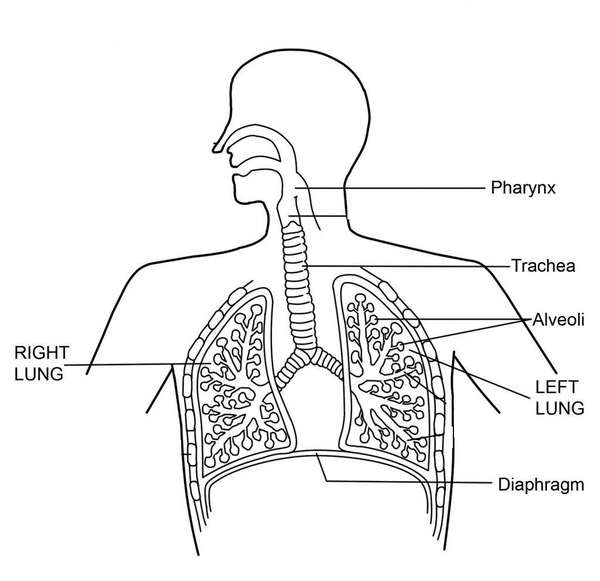
OR
(a) Name the organs that form the excretory system in human beings.
(b) Describe in brief how urine is produced in human body. [5]
Ans. (a) The organs that form the excretory system in human beings are:
- A pair of ureters
- A urethra
- A pair of kidneys
- A urinary bladder
(b) Urine is formed in the kidneys through filtration of blood. Each kidney consists of large numbers of filtration units called nephrons which filter out the waste products from the blood. Certain substances such as salts, glucose, amino acids and a major amount of water are reabsorbed as the urine flows along the tube of nephron. Urine then enters into ureter and gets stored in the urinary bladder until the pressure of the expanded bladder leads to the urge to pass it out through the urethra.

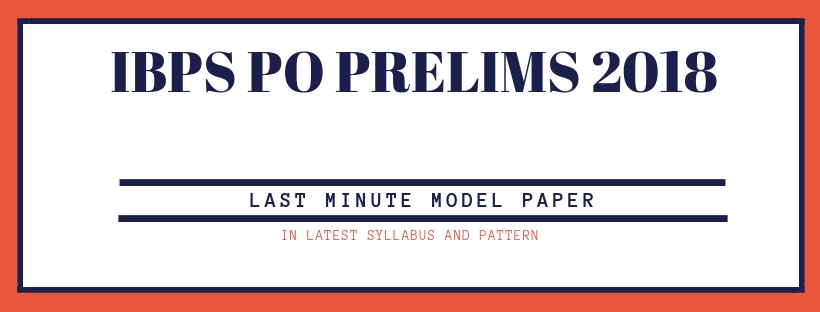
Improve your English
where is the solutions of set 3…………..
…………………………………first of all where is set 3 ?
.;. rather, the atempt of ur to all other is appreciable..
the way you attached the numeric answer is the most likely moment !!!!!!!!!!!
pls. attach the set 3 answers…………
i am an 14 yr student !!!! 10 passed !!! going to 15 on 3 may !!!!
RATHER IS USE THIS FOR MYSELF :-
#MINED & MATURE
Thank for sharing this question paper, Its really helps all student in their exams. Some best school in Gurgaon is also very committed to their students study.
Thank you… please provide the solutions of other sets of question papers also
SAME I SAID